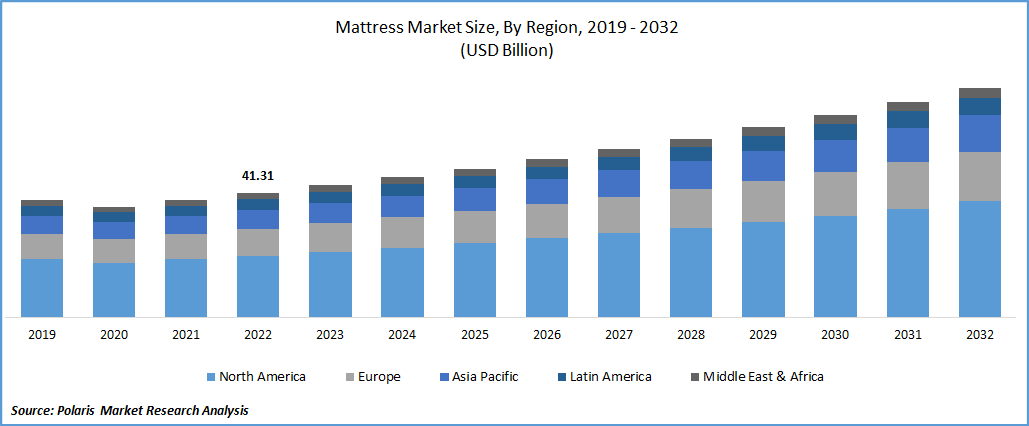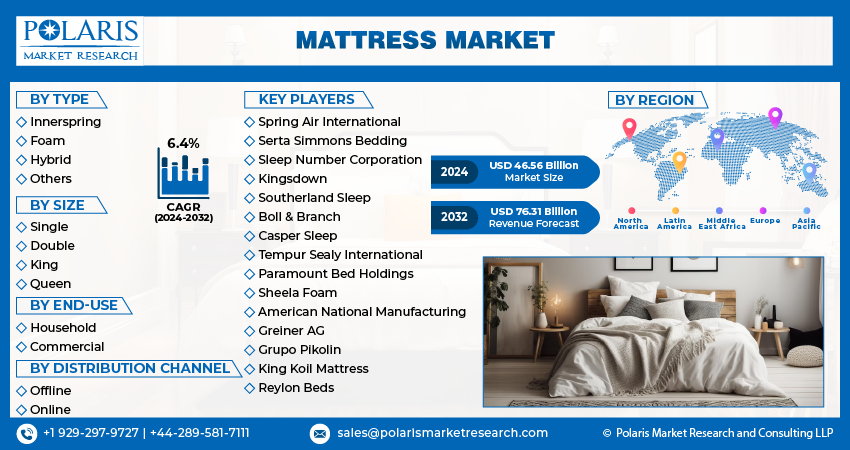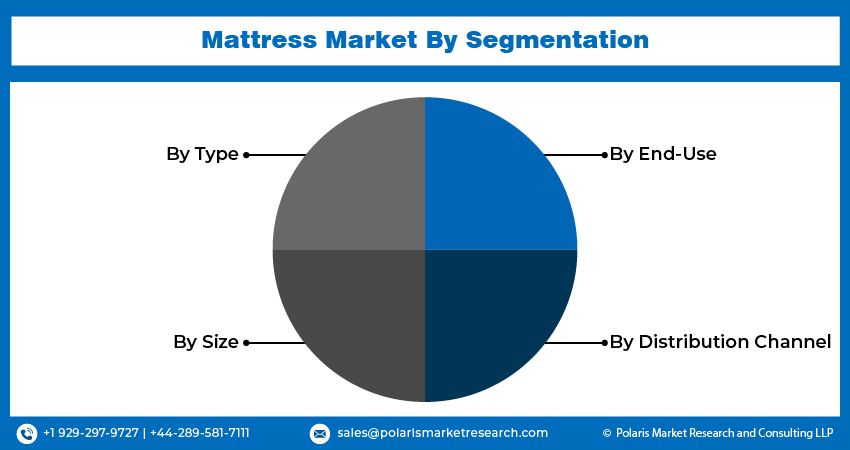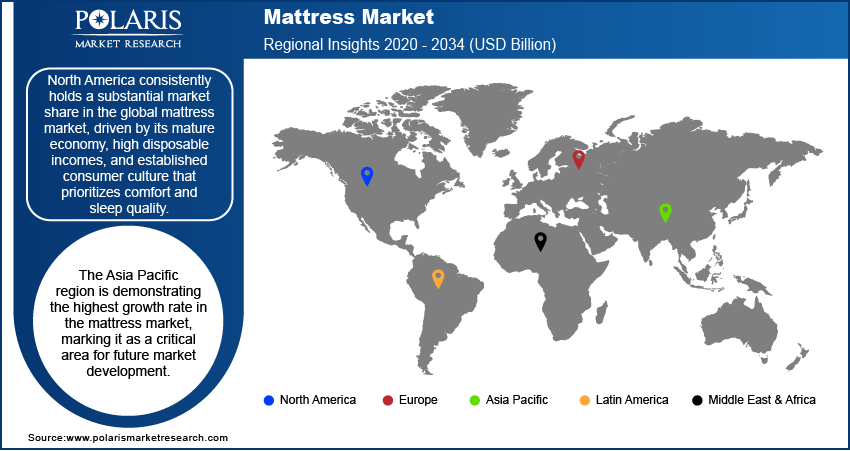
Mattress Market Size, Share, Trends & Industry Analysis Report
: By Type (Innerspring, Foam, Hybrid, and Others), By Size, By End Use, By Distribution Channel, and By Region– Market Forecast, 2025–2034
- Published Date:Aug-2025
- Pages: 115
- Format: PDF
- Report ID: PM3317
- Base Year: 2024
- Historical Data: 2020-2023
The mattress market size was valued at USD 46.60 billion in 2024, exhibiting a CAGR of 6.6% during 2025–2034. The market is driven by increasing awareness of sleep health, technological advancements in mattress design, and growing demand for luxury and specialty mattresses.
Key Insights
- Foam mattresses currently hold a significant market share, establishing themselves as a dominant segment in the mattress industry.
- Hybrid mattresses are rapidly growing, recognized for their high demand and innovation in comfort and support.
- Queen-sized mattresses consistently maintain a major share, driving market growth due to their popularity among consumers.
- The household segment leads the market, reflecting its essential role in everyday consumer living.
- Offline distribution channels, including brick-and-mortar stores and specialty sleep retailers, currently hold the largest market share.
- The North America mattress market remains substantial, driven by a mature economy, high disposable income, and a consumer culture focused on comfort and sleep quality.
Industry Dynamics
- Rising consumer awareness of health and wellness, along with increasing disposable incomes, is driving demand for premium and ergonomic mattresses.
- Growing urbanization and expansion of the hospitality sector are further boosting mattress market growth globally.
- High raw material costs and supply chain disruptions pose challenges to market expansion.
- Innovation in smart mattresses with advanced sleep technology presents significant growth opportunities.
Market Statistics
- 2024 Market Size: USD 46.60 billion
- 2034 Projected Market Size: USD 88.06 billion
- CAGR (2025-2034): 6.6%
- North America: Largest market in 2024

To Understand More About this Research: Request a Free Sample Report
The mattress market encompasses the production, distribution, and sales of mattresses designed to support the human body during sleep. Market dynamics are significantly influenced by a growing awareness of sleep health and sleeping aids and its impact on overall well-being. This increased consumer focus drives demand for comfortable and supportive mattresses, leading to continuous product innovation and technological advancements. Key drivers include rising disposable incomes, increasing urbanization, and a growing emphasis on healthy lifestyles. Additionally, the expansion of online sales channels offers consumers greater convenience and a wider selection of products.
The increasing demand for hybrid mattresses, which combine materials like memory foam and latex, caters to the consumer's need for enhanced comfort and support. The rising popularity of e-commerce platforms provides convenience, wider product selection, and competitive pricing, boosting growth. Furthermore, the growing awareness of sustainable materials has led to a demand for eco-friendly mattresses. These trends, coupled with technological advancements in smart mattresses featuring adjustable firmness and sleep tracking, are propelling the forward.
Industry Dynamics
Increasing Health Awareness and Focus on Sleep Quality
A major driver of the mattress industry is the growing global awareness of the vital role sleep health plays in overall well-being. Consumers are increasingly recognizing the negative impact of insufficient or poor-quality sleep on both physical and mental health. According to a 2024 report by the Sleep Foundation, 57% of men and 40% of women sleep less than seven hours per night on average—highlighting a significant public health concern. This heightened awareness is fueling demand for mattresses that provide advanced ergonomic support, enhanced comfort, and specialized features, thereby driving market growth.
Rising Disposable Incomes
The consistent rise in disposable incomes across various economies acts as a robust growth factor. As household incomes increase, consumers gain greater purchasing power, enabling them to invest in higher-quality, more advanced, and often more expensive mattresses. According to the U.S. Bureau of Economic Analysis (BEA), in February 2025, disposable personal income in the U.S. increased by 0.9 percent in January 2025. Similarly, the Press Information Bureau (PIB) of the Government of India reported in February 2024 that Private Final Consumption Expenditure was expected to grow by 7.6% during the fiscal year 2024-25. This allows for an upgrade from basic bedding to premium memory and flexible foam, hybrid, or smart mattresses, signifying a shift in consumer spending habits. This enhanced affordability and willingness to spend on comfort significantly influence the potential and development.
Growth of E-commerce Platforms
The rapid expansion and increasing penetration of e-commerce platforms serve as a powerful driver. Online retail channels offer unparalleled convenience, a vast selection of products, and often more competitive pricing, which appeals to a broad consumer base. The U.S. Census Bureau reported in May 2025 that U.S. retail e-commerce sales for the first quarter of 2025 increased by 6.1% from the first quarter of 2024, accounting for 16.2% of total retail sales. This growing adoption of online shopping has democratized access to mattresses, allowing consumers to research, compare, and purchase from the comfort of their homes, often benefiting from direct-to-consumer models and extended trial periods. This significant industry trend continues to reshape the dynamics and contribute to the overall size and penetration.

Segmental Insights
Market Assessment By Type
The market is segmented by type into innerspring, foam, hybrid, and others. Foam mattresses currently hold a significant share, establishing themselves as a dominant force within the mattress industry. This strong penetration is primarily attributed to their ability to offer superior pressure relief and motion isolation, catering to a wide range of consumer preferences. The inherent conforming properties of foam, particularly memory foam variants, allow for personalized comfort and support, which has resonated well with consumers seeking an enhanced sleep experience.
Hybrid mattresses are experiencing rapid development and are recognized for their high growth rate. This segment cleverly combines the benefits of traditional innerspring coils with layers of foam or latex, offering a compelling blend of support, bounce, and pressure relief. As consumers increasingly seek a balance between the familiar feel of springs and the contouring comfort of advanced foams, hybrid mattresses provide an optimal solution. The innovative design of hybrid mattresses allows for enhanced airflow compared to all-foam options and often provides superior edge support.
Market Evaluation By Size
The market is segmented by size into single, double, queen, and king. Queen mattresses consistently hold a significant share within the mattress industry, making them a leading driver. This size offers an optimal balance of space and practicality, making it highly popular among couples, individuals seeking more sleeping room, and those with moderately sized bedrooms. Its versatility allows it to fit comfortably in various living spaces, contributing to its broad penetration. The strong demand for queen mattresses is further supported by their widespread availability across different price points and material types, catering to a diverse consumer base.
King mattresses are demonstrating a robust growth rate, indicating a notable shift in consumer preferences towards larger sleeping areas. This rising demand is driven by an increasing desire for enhanced comfort and personal space, particularly among couples and families. As living spaces become more accommodating or consumers prioritize luxurious sleep environments, the appeal of a king-sized mattress intensifies. The trend towards larger beds also aligns with the growing potential for premium and specialty mattresses, as consumers investing in a king size are often seeking higher-quality and more advanced sleep solutions.
Market Evaluation By End Use
The market is segmented by end use into household and commercial. The household segment consistently commands the largest share in the mattress industry, reflecting its fundamental role in daily consumer life. The pervasive demand stems from individual and family purchases for residential use, driven by factors such as population growth, increasing household formations, and the regular replacement cycle of mattresses in homes. Consumers are increasingly prioritizing personal comfort and sleep health, leading to investments in higher quality mattresses for their residences. This sustained consumer interest and the sheer volume of household units contribute significantly to the overall size and robust dynamics of this end-use segment.
The commercial segment is experiencing a notable growth rate, driven by the expansion and modernization of industries like hospitality and healthcare. As global tourism rebounds and develops, there is increased demand from hotels, resorts, and vacation rentals to upgrade or replace mattresses to enhance guest experience. Similarly, the healthcare sector, including hospitals and nursing homes, is continually investing in specialized and comfortable mattresses for patient care, a crucial development. The ongoing renovation cycles within these commercial establishments, coupled with a focus on providing superior comfort and hygiene, contribute to the accelerating growth and potential for commercial mattress sales.
Market Evaluation By Distribution Channel
The market is segmented by distribution channel into offline and online. The offline distribution channel, primarily encompassing brick-and-mortar stores and specialty sleep retailers, currently holds the largest share in the mattress industry. This dominance is largely due to the consumer preference for physically experiencing a mattress before purchase, allowing them to assess comfort, firmness, and material quality directly. Traditional retail environments also offer immediate product availability and the benefit of in-person sales assistance, which can be crucial for such a significant household investment. Despite the rise of digital alternatives, the established infrastructure and consumer trust in physical showrooms continue to drive significant demand and maintain the prominent position of offline sales.
The online distribution channel is experiencing a rapid growth rate. This acceleration is fueled by the increasing consumer inclination towards convenience, broader product selection, and competitive pricing offered by e-commerce platforms and direct-to-consumer (DTC) brands. The ease of comparing different mattress types, reading customer reviews, and arranging for convenient home delivery, often with trial periods, has significantly boosted potential. As digital literacy and online shopping habits continue to expand, the online channel is strategically positioned for sustained development, gaining increasing share and reshaping the future outlook for mattress sales.

Regional Analysis
North America mattress market consistently holds a substantial share, driven by its mature economy, high disposable incomes, and established consumer culture that prioritizes comfort and sleep quality. The region benefits from a strong awareness of sleep health, encouraging consumers to invest in premium and technologically advanced sleep solutions. The presence of major players and a well-developed distribution network, including both robust offline retail and a rapidly expanding online presence, further solidifies its dominant position. Continuous product innovation and effective marketing strategies aimed at a discerning consumer base ensure sustained demand and a stable size in North America.
The Asia Pacific mattress market is demonstrating the highest growth rate, marking it as a critical area for future development. This rapid expansion is fueled by significant economic growth, increasing urbanization, and a burgeoning middle-class population with rising disposable incomes. Countries within this region are witnessing a transformative shift in consumer lifestyles, with a growing emphasis on modern home furnishings and health-conscious choices. The increasing penetration of online retail channels, coupled with growing awareness of sleep health benefits, is further accelerating potential. This dynamic combination of demographic shifts and economic prosperity makes Asia Pacific a powerhouse for future growth.

Key Players and Competitive Insights
Key players in the mattress market include prominent companies such as Sealy (Tempur Sealy International, Inc.), Serta Simmons Bedding LLC), Sleep Number, Kingsdown Inc., Kurlon Enterprise Ltd., Peps Industries Private Limited, Duroflex Pvt. Ltd., Wakefit, and The Sleep Company.
The mattress market is highly competitive, featuring both established global corporations and emerging direct-to-consumer brands. Competition revolves around product innovation, pricing strategies, and distribution network efficiency. Companies are investing heavily in research and development to introduce advanced technologies like memory foam, hybrid constructions, and smart features such as sleep tracking and adjustable firmness. Sustainability and eco-friendly materials are also becoming increasingly important differentiators. Digital marketing and e-commerce play a crucial role in enhancing brand visibility and reaching a wider consumer base.
List of Key Companies
- Ashley Furniture
- Duroflex Pvt. Ltd.
- Kingsdown Inc.
- Kurlon Enterprise Ltd.
- Peps Industries Private Limited
- Sealy (Tempur Sealy International, Inc.)
- Serta (Serta Simmons Bedding LLC)
- Sleep Number
- The Sleep Company
- Wakefit
Industry Developments
- May 2025: Saatva named Official Mattress and Restorative Sleep Partner of Team USA and the LA28 Olympic Games.
- February 2025: Tempur Sealy International, Inc. announced its plan to change its name to Somnigroup International Inc. This rebranding followed the successful completion of its acquisition of Mattress Firm, reflecting the company's expanded global omnichannel strategy and position as a broader sleep solutions provider.
- January 2025: Serta Simmons Bedding LLC launched its new Beautyrest and Beautyrest World Class collections. This major product launch represents a strategic effort to complete its brand portfolio, offering mattresses across various price points to support a wider range of sleepers.
Market Segmentation
By Type Outlook (Revenue – USD Billion, 2020–2034)
- Innerspring
- Foam
- Hybrid
- Others
By Size Outlook (Revenue – USD Billion, 2020–2034)
- Single
- Double
- Queen
- King
By End Use Outlook (Revenue – USD Billion, 2020–2034)
- Household
- Commercial
By Distribution Channel Outlook (Revenue – USD Billion, 2020–2034)
- Offline
- Online
By Regional Outlook (Revenue-USD Billion, 2020–2034)
- North America
- US
- Canada
- Europe
- Germany
- France
- UK
- Italy
- Spain
- Netherlands
- Russia
- Rest of Europe
- Asia-Pacific
- China
- Japan
- India
- Malaysia
- Suth Korea
- Indnesia
- Australia
- Vietnam
- Rest of Asia-Pacific
- Middle East & Africa
- Saudi Arabia
- UAE
- Israel
- Suth Africa
- Rest of Middle East & Africa
- Latin America
- Mexic
- Brazil
- Argentina
- Rest of Latin America
Report Scope
|
Report Attributes |
Details |
|
Market Size Value in 2024 |
USD 46.60 billion |
|
Market Size Value in 2025 |
USD 49.56 billion |
|
Revenue Forecast by 2034 |
USD 88.09 billion |
|
CAGR |
6.6% from 2025 to 2034 |
|
Base Year |
2024 |
|
Historical Data |
2020–2023 |
|
Forecast Period |
2025–2034 |
|
Quantitative Units |
Revenue in USD billion and CAGR from 2025 to 2034 |
|
Report Coverage |
Revenue Forecast, Market Competitive Landscape, Growth Factors, and Industry Insights |
|
Segments Covered |
|
|
Regional Scope |
|
|
Competitive Landscape |
|
|
Report Format |
|
|
Customization |
Report customization as per your requirements with respect to countries, regions, and segmentation. |
How is the report valuable for an organization?
Workflow/Innovation Strategy: The mattress market has been segmented into detailed segments of size, type, end use, and distribution channel. Moreover, the study provides the reader with a detailed understanding of the different segments at both the global and regional levels.
Market Entry Strategies: Growth and marketing strategies are increasingly focused on leveraging digital channels and emphasizing consumer education. Companies are employing robust online marketing campaigns, including social media engagement, influencer collaborations, and search engine optimization, to capture diverse demand. Strategic partnerships with e-commerce platforms and the development of direct-to-consumer (DTC) models are crucial for expanding penetration and optimizing distribution. Furthermore, continuous product innovation, highlighting advanced materials and personalized comfort, remains a key driver, enabling brands to differentiate themselves and capture a larger share through a strong outlook.
FAQ's
The global size was valued at USD 46.60 billion in 2024 and is projected to grow to USD 88.09 billion by 2034.
The market is projected to register a CAGR of 6.6% during the forecast period, 2024-2034.
North America had the largest share of the market.
Key players include Sealy (Tempur Sealy International, Inc.), Serta Simmons Bedding LLC), Sleep Number, Kingsdown Inc., Kurlon Enterprise Ltd., Peps Industries Private Limited, Duroflex Pvt. Ltd., Wakefit, and The Sleep Company.
The queen segment accounted for the largest share in 2024.
Here are some key trends: ? Rise of Smart Mattresses: Integration of technology for sleep tracking, adjustable firmness, temperature control, and connectivity with smart home systems. ? Emphasis on Health and Wellness: Growing consumer awareness of sleep's impact on health drives demand for orthopedic support, ergonomic designs, and mattresses addressing sleep disorders. ? Sustainability and Eco-Friendly Materials: Increased focus on mattresses made from natural, organic, and recycled materials like natural latex, organic cotton, and bamboo, alongside brand recycling initiatives.
A mattress is a pad, typically rectangular, that is designed to be used as a bed, or as part of a bed. It is usually placed on a bed frame and supports a person while they sleep or rest. Mattresses are constructed from various materials, including springs, foam (such as memory foam or latex foam), air, or water, often covered with a quilted or woven fabric casing. Their primary function is to provide comfort, support, and pressure relief to the body, contributing to proper spinal alignment and an optimal sleep experience.
